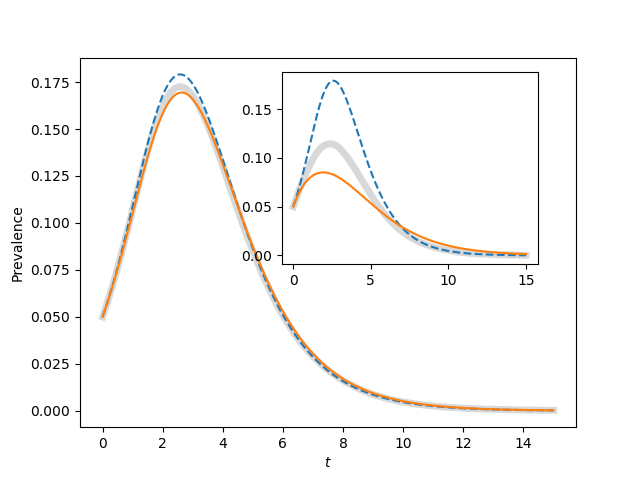import EoN
import networkx as nx
import matplotlib.pyplot as plt
import scipy
r'''
Reproduces figure 4.13
With N=1000, there is still significant stochasticity. Some epidemics have earlier
peaks than others. When many of these are averaged together, the final outcome
is that the average has a lower, broader peak than a typical epidemic. In
this case it tends to make the Erdos-Renyi network for <K>=50 look like a better
fit for the homogeneous_pairwise model.
Increasing N to 10000 will eliminate this.
'''
print("Often stochastic effects cause the peak for <K>=50 to be lower than predicted.")
print("See comments in code for explanation")
N=10000
gamma = 1.
iterations = 200
rho = 0.05
tmax = 15
tcount = 1001
report_times = scipy.linspace(0,tmax,tcount)
ax1 = plt.gca()#axes([0.1,0.1,0.9,0.9])
ax2 = plt.axes([0.44,0.45,0.4,0.4])
for kave, ax in zip((50, 5), (ax1, ax2)):
tau = 2*gamma/kave
Isum = scipy.zeros(tcount)
for counter in range(iterations):
G = nx.fast_gnp_random_graph(N,kave/(N-1.))
t, S, I, R = EoN.fast_SIR(G, tau, gamma, tmax=tmax, rho=rho)
I = I*1./N
I = EoN.subsample(report_times, t, I)
Isum += I
ax.plot(report_times, Isum/iterations, color='grey', linewidth=5, alpha=0.3)
S0 = (1-rho)*N
I0 = rho*N
R0=0
t, S, I, R = EoN.SIR_homogeneous_meanfield(S0, I0, R0, kave, tau, gamma,
tmax=tmax, tcount=tcount)
ax.plot(t, I/N, '--')
SI0 = (1-rho)*N*kave*rho
SS0 = (1-rho)*N*kave*(1-rho)
t, S, I, R = EoN.SIR_homogeneous_pairwise(S0, I0, R0, SI0, SS0, kave, tau, gamma,
tmax=tmax, tcount=tcount)
ax.plot(t, I/N)
ax1.set_xlabel('$t$')
ax1.set_ylabel('Prevalence')
plt.savefig('fig4p13.png')
